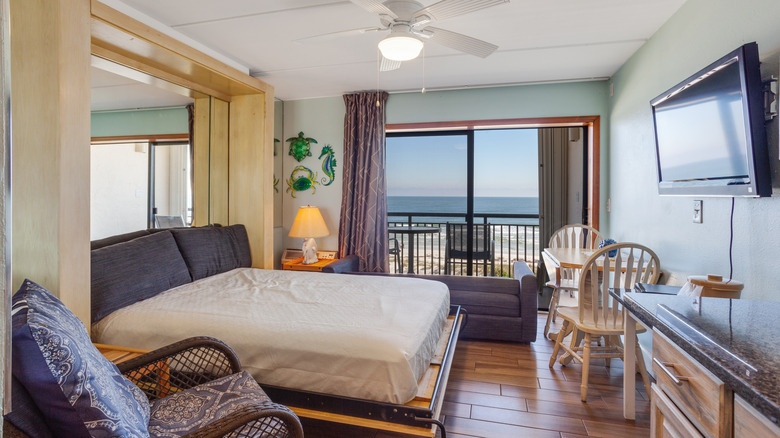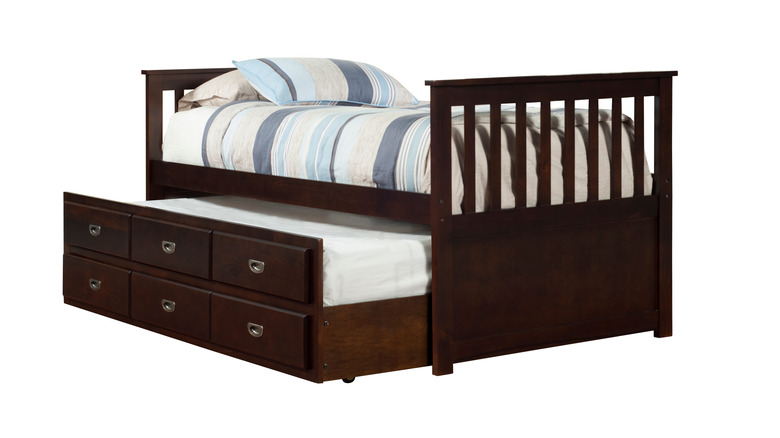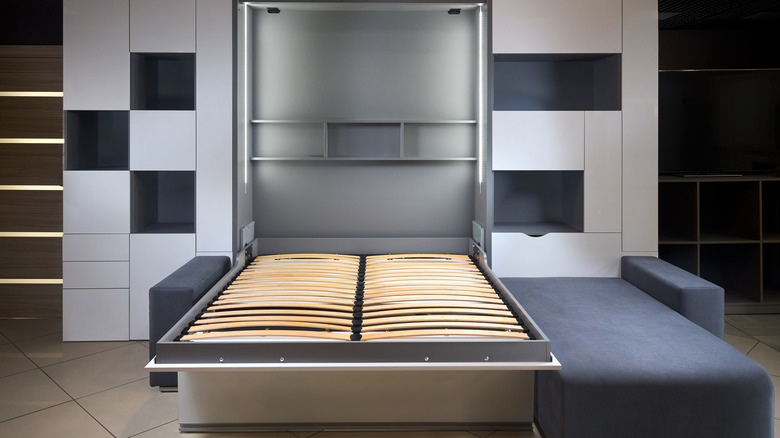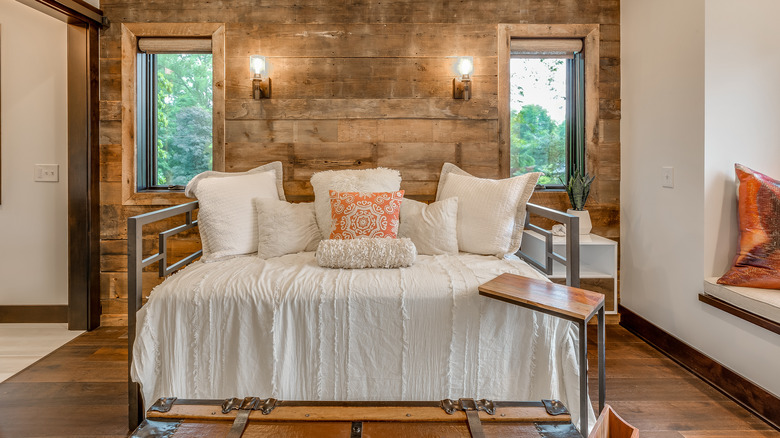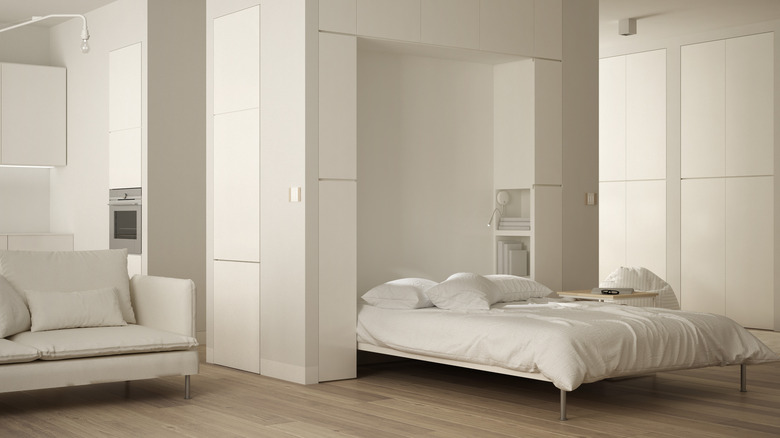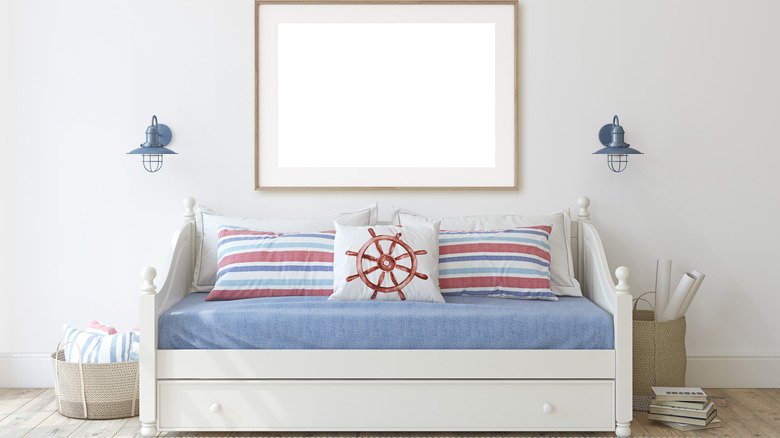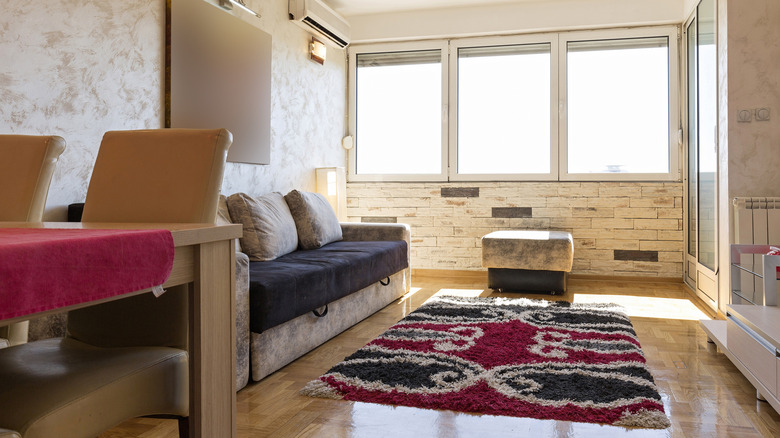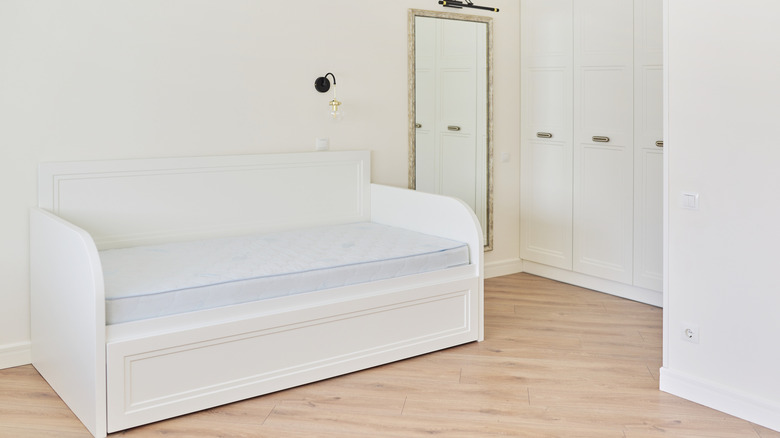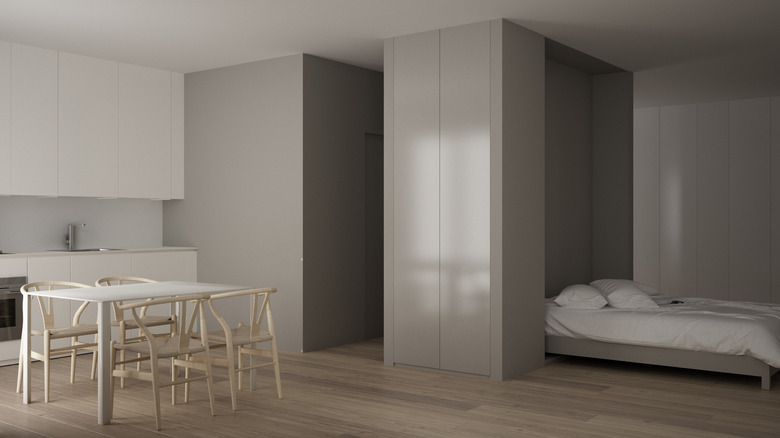Trundle Bed Vs. Murphy Bed: What's The Difference?
When it comes to designing and cleverly creating more space in your bedroom, you'll likely come across people recommending both trundle beds and murphy beds. Trundle beds conveniently and discreetly hide an extra mattress under the main bed, whereas murphy beds fold into the wall when not in use, explains Furnishing Tips.
There are some key differences between the two beds, though. While they are both designed for conserving space in your home, they are ideal for different situations. Not everyone needs an extra mattress, for example, whereas some people may not need or have the means to store a murphy bed. There are other concerns and factors like cost, size, durability, and safety to keep in mind. Differences in living situations (a studio or tiny home versus an apartment, condo, duplex, house, etc.), family size (single versus married, kids, roommates, etc.), and lifestyle all factor into which bed is best for you.
How does the appearance differ?
The varying appearances are one of the most easily identifiable differences between trundle beds and murphy beds. Trundle beds are commonly referred to as daybeds, often used as both a sofa and bed, according to Mattress Nut. They can come with a couch-shaped headboard for seamlessly blending into your living room disguised as seating. Some trundle beds are designed to look like a simple raised twin bed with a mattress drawer underneath.
On the other hand, murphy beds are generally all very similar in appearance. At least, the basic premise is the same, a bed that can be folded up and into the wall, disguised as a cabinet or shelf when not in use. There are some natural variations in appearance, though. Some fancier murphy beds will have a built-in desk, couch, or shelving unit, for example. They also have a larger range in terms of size when compared to trundle beds.
What are the differences in cost?
Another major difference between trundle beds and murphy beds is the cost. Trundle beds are generally much cheaper. Mattress Nut lists the average price for trundle beds anywhere from $205 to $630, whereas murphy beds range from $1,725 to as much as $2,535.
Trundle beds are less expensive because they are essentially just a piece of furniture. While you can buy higher-end and more costly models, all that's required to assemble them is an instruction manual and a toolkit or a small assembly fee. Murphy beds, on the other hand, are a home installation feature. Murphy beds need to be mounted into the wall, ceiling, and floor to be safe for use, which will almost always require professional installation services.
Trundle beds also typically have a much less complicated structure than murphy beds, simply including the frame, pull-out, and the two mattresses. Murphy beds involve a lot more parts, even simple ones, including a bed, bed frame, cabinet or shelf, and assembly parts. Complicated designs, including desks or sofas, will only add to that cost.
Pros and cons of trundle beds
Trundle beds are a great option for creating more sleeping space, but they're not for everyone, and it's important to consider the pros and cons of the item before purchasing. Trundle beds are commonly used in guest rooms to create more occasional sleeping space, in kid's rooms for sleepovers, and in small spaces like studios or tiny homes in the form of a daybed. In this case, a major pro is being able to create more sleeping space without disrupting the entire room. According to Well Worth Living, they're also safer than other space-saving sleeping options like bunk beds.
That being said, there are some drawbacks to trundle beds. For one, they can limit storage space. If you're considering a trundle bed, odds are you're already cramped for space, and underneath the bed can be valuable storage space you eliminate through a trundle bed. And while they're safer in terms of major injuries, for instance, falling off a top bunk, children can easily get their fingers pinched in the drawer. Lastly, since the bottom mattress is stuck in a drawer most of the time, it gets mustier and dirtier much more frequently.
Pros and cons of murphy beds
Murphy beds have both advantages and disadvantages to consider before purchasing, especially since it's a more permanent option. Murphy beds have plenty of pros, primarily how much space they save. In small spaces, your bed can be a major hindrance. Murphy beds conveniently and discreetly tuck away your bed until you need it. They also can come with many customizations or add-ons for extra storage notes Upgraded Home. Some murphy beds have interior shelves that serve as a bedside table when open. Murphy beds can also come with shelving, storage, sitting areas, and desks on the outside, making them functional for a small space.
There are also some downsides to murphy beds to consider. First, they're expensive due to a few factors, including the installation process. That leads to the next con that they're a permanent feature. As A Goodly Home says, there's not much rearranging that can be done with a murphy bed. And while they're convenient in terms of saving space, it can be inconvenient to fold the bed in and out every morning and night. Finally, there are some safety concerns surrounding murphy beds if not correctly installed and maintained.
Are trundle beds safer than murphy beds?
In general, trundle beds are safer than murphy beds. As stated earlier, trundle beds are a safer option than bunk beds, though there is the potential risk of children pinching their fingers if they try to pull out the bottom mattress on their own. However, according to Furnishing Tips, most trundle beds are too heavy for kids to move on their own, which mostly eliminates this risk.
Murphy beds are generally completely safe. It is somewhat of a cartoonish gimmick to show people smashed in a faulty murphy bed, but that is a very rare occurrence in real life. As Lori Wall Beds states, a properly and professionally installed, murphy bed does not pose any safety hazards. In fact, dryer lint, extension cords, space heaters, and ceiling fans are more likely to result in injury or death than murphy beds. That being said, it is vital that you contract a reputable professional to install the bed and properly maintain it.
Durability and maintenance
With any furniture purchase, you want it to last as long as possible, especially with a piece as central as a bed. Since murphy beds are a permanent fixture in your home, long-term maintenance is important. Since there's a lot of daily wear and tear on murphy beds, pulling them up and down every day, they'll usually last anywhere from 13 to 16 years, according to Mattress Nut.
There are some things you can do to extend the life of your murphy bed. While regular cleaning of the frame and mattress is necessary for a long life, Murphy Beds of San Diego also recommends checking the screws and components occasionally and replacing them when needed. Always treat the bed with care and gentleness to prevent it from warping or being damaged.
Trundle bed frames will generally last a long time since there isn't much wear and tear as with a murphy bed. They should, of course, be treated gently and cleaned often. Trundle beds that pull up and connect to one level may begin to separate, warns SFGate. If that happens, locking wheels, rope ties, and cable ties are all options that can help with this issue.
Differences in sizes
Another key difference between trundle beds and murphy beds is their sizes. Typically, murphy beds offer more size variety than trundle beds. According to Furnishing Tips, most trundle beds come equipped with a twin-sized mattress, but if pulled up and connected, form a full-size mattress. A trundle bed frame will generally not be found larger than full-sized.
Murphy beds are a little more flexible in terms of sizing options. You can find a murphy bed for any mattress size, from a twin to a king or even bigger since they're often customizable. That being said, murphy beds take up a lot more permanent wall space than a trundle.
Another difference in size between trundle and murphy beds is how they'll be displayed. A trundle bed often functions as a couch during the day, so you can incorporate it a bit more seamlessly into your home. That does require it to be smaller, though. With murphy beds, you'll save floor space by hiding your bed. However, you'll also have to accommodate the surrounding space to ensure there's room to pull it out, so while you can get a bigger size, it may be a bigger hassle.
When to choose trundle beds over murphy beds
The last thing to factor in when deciding between a trundle bed or a murphy bed is which is more practical. Trundle beds may be smaller; they blend into a room more and have a double function as a couch and bed. On the other hand, murphy beds are more discreet but are more expensive and require daily labor and space to pull them down.
Both beds are ideal for small spaces, like studio apartments or tiny homes. However, murphy beds may have the edge over trundles for small spaces, notes Mattress Nut, where they can easily fold away and create more living space, which is precious in close quarters.
Trundle and murphy beds are both convenient for having guests over. In this scenario, though, trundle beds tend to take the lead. For children having friends over, or an office or living room you want to be able to easily but tastefully convert into a guest room, trundle beds provide a visually pleasing but practical solution. Murphy beds will work in this situation, but they may be difficult for guests to use and take away from the flow of a room.
